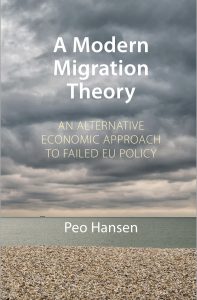Peo Hansen

Over a few days this past summer, as I was putting the finishing touches to my book, A Modern Migration Theory, my daughter developed a pain in her left foot after having twisted her ankle. As the pain persisted we went to see a doctor. In the waiting room at the local clinic I took note of the fact that seven of the ten doctors in the corridor had foreign names, three of which were Muslim. I have seen doctors from Iraq, Romania and Syria at this clinic, which was no coincidence given that Iraqi and Romanian doctors make up two of the largest groups within the cohort of foreign-born doctors in Sweden. More than 30 per cent of all doctors in Sweden are born abroad (OECD 2019), and in the case of Iraqi doctors most of them arrived as refugees in the noughties. My daughter was examined by a doctor from Germany who swiftly referred her to the main hospital for an X-ray.
We took a taxi to the hospital, and here as well the person servicing us was foreign-born, maybe from Syria. Around a half of Sweden’s taxi drivers are foreign-born and the great majority have come as refugees (Statistics Sweden 2019; 2020). The driver dropped us off at the emergency room entrance, and from there we had to ask for directions to the X-ray department. We were helped by a doctor and nurse who came walking our way. Judging from their ID badges it seemed as if the doctor was from an African country and the nurse from a Middle Eastern country. In all likelihood, the nurse who took care of my daughter in the X-ray department was also from a country in the Middle East. Close to 15 percent of the nurses working in Sweden come from other countries (OECD 2019).
Luckily, the X-ray indicated no fracture, and so we headed for the bus stop to go home. There was a bus sitting at the kerb, but the driver told us that it would take a while before it would depart. With my daughter in some pain we decided to take a taxi again. This time our driver might have been from Somalia; the same probably applied to the bus driver. Over a half of those working as bus and tram drivers in Sweden are born in another country, and, needless to say, almost all of them have come as refugees. I think I have made my point. But I should mention too that we also passed by a team of cleaners in the hospital. The pattern repeated itself, and no coincidence in this case either. Sixty per cent of the cleaners in Sweden are foreign-born, and, yes, the majority have refugee background (Statistics Sweden 2019; 2020). They clean Sweden for very low pay, and they have continued to fulfil this absolutely essential public function during the Covid-19 pandemic.
My daughter and I had an excursion into the Swedish reality. In this reality people who have come as refugees carry out absolutely vital work without which the Swedish society and economy would cease to function. Close to 30 percent nationally, and about 55 percent in the Stockholm region, of those working in the Swedish elderly care are foreign-born – practically all of them have refugee background (Socialstyrelsen 2019: 47). Although it refuses to acknowledge this fact in the public debate, in a report from 2018 even the Swedish government (2018: 16) concedes as much: “Without the foreign-born women and men, the elderly care would face significant problems in fulfilling its task.”
“Without the foreign-born women and men, the elderly care would face significant problems in fulfilling its task.”
Again, this is the reality and the numbers are there for everybody to see. Yet this reality persistently fails to register in national and European debates on asylum and migration. The seriousness of this deliberate omission cannot be overemphasized, and it is one of the main reasons why I decided to write a book about it.
Instead of broadcasting the real benefits that refugees and labour migrants bring to EU countries and, from there, enact policy to improve migrants’ often precarious situation, the political establishment has done the opposite. It has made sure to soak and trap the European Union in a toxic debate over an alleged plethora of negative effects of migration – though “highly skilled” migration is sometimes spared.
The Cost Perspective on Migration
Integral to this is the ubiquitous cost perspective on migration, which makes up one of the most powerful shields against the EU’s migration reality. This perspective, or narrative, is the main focus of my book. As I describe in great detail, not only politicians but also researchers today agree that refugees admitted to the European Union constitute a net cost and fiscal burden for the receiving societies. Whereas researchers draw this conclusion from a seemingly neutral accounting exercise – refugees are said to contribute less in taxes than they receive in welfare assistance – politicians and the media eagerly use this “economic science” to justify and explain restrictive asylum policies. To be sure, politicians and researchers may judge low-earning and low-skilled labour migrants to be both necessary and affordable, but only on the condition that their access to welfare provisions is restricted. This does not apply to refugees, however. Since refugees cannot work and pay taxes from day one and since they may have children, refugees will initially always depend on welfare assistance. By definition, therefore, they are deemed fiscal burdens.
From the perspective of research this is just a scientific fact, and so research cannot be held accountable for being complicit in stoking the sentiment that refugee reception and low-earning migrants jeopardize the welfare state and that, consequently, refugee prevention constitutes a prerequisite for the fiscal viability of the welfare state. As one expert in the field puts it: “The lower the skills and earnings of migrants in the host country, the greater will be the strictly economic case for restricting some of their welfare rights in order to minimize the fiscal costs for existing residents” (Ruhs 2013: 46).
The “strictly economic” serves to indicate that the issue at hand is neither grounded nor decided within the realm of political choice. Rather, economic laws of fiscal sustainability are said to constrain what is politically feasible.
According to world-renowned economist Branko Milanovic, “[t]he arrival of migrants threatens to diminish or dilute the premium enjoyed by citizens of rich countries, which includes not only financial aspects, but also good health and education services.” Yes, you read right, migrants working in the health services are supposedly diluting “the premium enjoyed by citizens of rich countries”. Admitting low-earning migrants therefore “requires withholding some civic rights”, Milanovic asserts. “We can debate the sharpness of the trade-off, but cannot deny its existence.” (Milanovic 2016a: 152) In Milanovic’s (2016a: 152) quest to figure out ways to “pay for increased migration”, such withholding of rights to migrants – or “discriminatory treatment”, as he terms it – are both necessary and beneficial to all (2016b). Migrants, Milanovic (2016b) suggests, “could also be made to pay higher taxes since they are the largest net beneficiaries of migration”.
Finally, here’s another representative scholarly view, published in a recent issue of the International Organization of Migration’s (IOM) journal International Migration: “The refugees represent a fiscal burden for the host countries at least short and medium term. Under these conditions refugee migration is unable to help to alleviate the aging related fiscal burden of the host societies, on the contrary, it contributes to its worsening. Thus, when the majority thinks that refugees represent a fiscal burden (they “take out more from the public purse than they pay in”), they are not wrong this time. It is not possible to argue against this with solid empirical evidence. Naturally, the moral (and legal) obligation argument for accepting the refugees is still valid but it couldn’t be underpinned with further economic reasoning. The moral obligations and the economic benefit are in conflict here (Gál 2019: 352).
As communicated in the quote, “the majority [is] not wrong this time”, implying that, though majorities may be wrong most of the time, on the issue of refugees they are not. Here, the majority opinion is in agreement with science. The political parties on the extreme right have always had this piece of “economic science” tattooed into their party programmes and flagship slogans. Here is an instance when Europe’s extreme right cannot be dismissed as populists or as being guilty of simplifying complex issues. As asserted in the quote, the factuality of refugees constituting a “fiscal burden” “is not possible to argue against […] with solid empirical evidence”. And since a fiscal burden, per definition, is synonymous with something very negative in the public debate, we should not be surprised if politicians and the public take those making up the burden – i.e. the refugees – to be undesirable too.
It is like starting a discussion about equal pay by insisting that we acknowledge that women are a fiscal burden on men because women pay less in taxes – and that trying to diminish or hide this “fact” only plays into the hands of the sexists.
In response to this, the proponents of the cost perspective simply say that to mask or hide the truth about refugee migration – or any other migration deemed costly – goes against the scientific ethos and that it would make for an even worse place to begin integration. Many would add that tampering with the truth will only aid the anti-immigration populists – a particularly common retort from mainstream politicians and scholars who want to mark their distance from the extreme right. Since so few challenge the basic principles and maths of the cost perspective, it has gained an air of unassailable truth. But those who claim that they side with accuracy in order to avoid playing into the hands of the anti-immigration right do something even worse than allowing the cost assumption to stand unchallenged. They give it new life and credibility by insisting it be acknowledged in advance. It is like starting a discussion about equal pay by insisting that we acknowledge that women are a fiscal burden on men because women pay less in taxes – and that trying to diminish or hide this “fact” only plays into the hands of the sexists.
A Modern Migration Theory
My book is not just an argument to debunk the cost perspective’s detrimental impact on migrants’ integration and inclusion. Employing the descriptive macroeconomic framework provided by the scholars within Modern Monetary Theory (MMT), it also demonstrates that the cost perspective builds on a flawed economic conception (see e.g. Ehnts 2017; Mitchell, Wray & Watts 2019). Much of this is attributable to the heavy imprint of the orthodox “sound finance” doctrine on migration research and policy – the assumption that governments face a budget constraint much in same way as households, municipalities and businesses. This orthodox “sound finance” economics and its household accounting thus mistakes state spending for being precisely that: analogous to household spending. Here, therefore, spending amounts to little more than a cost, in the same way that a household looks at its outlays – i.e. as something that subtracts from the household’s income, savings or borrowed money. As a consequence, the money spent on refugees would have to be made up for through tax hikes or “risky” borrowing or by removing funds from other areas, such as welfare benefits intended for needy citizens.
For countries that issue their own currencies, however, none of this applies. Since the central government is the monopoly issuer of the currency, it follows, both in logical and in concrete terms, that it necessarily has to spend or lend the currency (via the banking system) into existence before it can collect it back in taxes. If this was not the case, there would be no money to pay taxes with. Such governments are thus the exact opposite of municipalities, business and households, all of which have to collect, earn or borrow the money before they can spend it; they are mere users of money, not issuers. Hence, and as MMT explains, currency-issuing governments are not revenue-constrained. This means that taxes collected by the central government are not used to fund government spending as they are when collected by currency-using bodies such as municipalities or constituent states in federations (or as in the eurozone prior to ECB’s adoption of the Pandemic Emergency Purchase Program, see Ehnts 2020).
Central government taxes fulfil other indispensable functions and purposes. By constantly removing a large chunk of money – and thus spending power – from the private sector, taxes work as a powerful anti-inflationary measure while at the same time moving resources from the private to the public sector. Taxes also work as an instrument regulating income and wealth distribution and they are used to promote or discourage certain industries, professions and behaviours. And there are, of course, other purposes that central government taxes can be made to fulfil – but revenue for spending and saving for future spending do not form part of them. Again, as the monopoly issuer of the currency, the government can always spend its own currency.
Had it been seriously pondered, I suspect the whole notion of the potential unsustainability of refugee spending would have had to be reconsidered. In other words, what is so bad or dangerous about households, businesses and municipalities receiving net incomes?
As MMT also demonstrates – and as the historical pandemic-spending corroborates – money spent never disappears, and this, of course, applies to all monetary systems everywhere. This is so because all central government spending, by definition, must end up somewhere and hence be collected by someone. Spending by the central government is thus synonymous with income in the non-central government sector – as such, spending always equals income. In the scholarly literature on the fiscal impact of migration as well as in fiscal policy-making, this irrefutable fact is never considered, which, when one comes to think about it, is strange indeed. Had it been seriously pondered, I suspect the whole notion of the potential unsustainability of refugee spending would have had to be reconsidered. In other words, what is so bad or dangerous about households, businesses and municipalities receiving net incomes?
Real Resources, Financial Resources
What may be even more serious is that scholars and policy-makers also fail to understand why we need to distinguish between real resources, such as labour, and financial resources. Reflecting this failure, researchers cannot grasp the value and indispensability of the labour performed by those 60 per cent of cleaners in Sweden who are born abroad. Instead, they conceive of these workers as fiscal burdens. Their tax contributions fall below average and so they are said to receive more in government welfare spending than they pay in. By always being in the red, so to speak, these workers will neither be able to redeem the costs for their initial stay in the country during which they did not work and pay taxes at all. Of course, if refugees work as doctors they will be able to offset such alleged costs, and they may also be able to offset additional costs, such as their children’s schooling. But, if they work as cleaners, they remain perpetual net costs. According to this logic, then, Sweden would have been better off without the cleaners who came as refugees.
This is silly and absurd reasoning. To deem people as fiscal assets or fiscal burdens depending on which side of the average for tax payments they fall is to misunderstand society. Not everyone can earn above-average incomes, as, by definition, some will be above whereas some will be below. What purpose does it serve to consign those who earn below “average” to the status of costs and burdens when, as everyone ought to know too, society is impossible without them? What would society be like if no one worked in food production, if no one cleaned, cared for children and the elderly, drove the buses or worked as assistant nurses?
To deem people as fiscal assets or fiscal burdens depending on which side of the average for tax payments they fall is to misunderstand society.
As I explain in my book, the real resource contribution from the foreign-born nationals to the Swedish society has been nothing less than astounding. With fewer Swedish-born workers joining the labour force than leaving it, the entire addition of working age people in Sweden has, since 2008, consisted of the foreign born. Between 2010 and 2017 the number of working age (16–64) Swedish-born people dropped by over 150,000 while the number of working age foreign-born grew by some 360,000 people (SPES 2018). In this period, Sweden was thus able to increase its working age population by more than 200,000. This growth will pick up even more until 2025, when the foreign-born share of the working age is set to hit 27 percent, as compared to 18 percent in 2010. Because of this, Sweden is the only country in the EU (and beyond) that has not seen an increase in the median age over the last decade. The figures for 2017 illustrate this well. Here, the labour market added 94,000 jobs, of which 75,000, or 80 percent, went to foreign-born workers (SPES 2018: 26). According to the Swedish Public Employment Service (SPES 2018), this pattern is likely to continue.
Crucial too is that refugees in Sweden have disproportionately ended up in smaller, rural municipalities. Many of these municipalities appreciate refugees as vital in making local communities liveable again, helping to reverse a decades-long vicious spiral of depopulation, declining local tax revenue and welfare service retrenchment. Thanks to refugee reception, municipalities that were closing schools are now opening them and building new ones instead.
Thanks to refugee reception, municipalities that were closing schools are now opening them and building new ones instead.
Concerning the financial aspects, during the three years 2015–2017, as I detail in the book, the Swedish central government increased spending massively to manage the reception of 163,000 refugees. In 2015, and for many years prior to that, Sweden had been the largest recipient, proportionally speaking, of asylum seekers in the EU. Most of the funds went to the municipalities that received the refugees. But the government made sure to inform the public that the spending was a necessary evil that would impact negatively on the Swedish economy and welfare state – this was the message that was repeated by the government over and over again. In addition, practically all economic expertise warned in unison of economic and financial damage, urging the government to trim spending and introduce austerity measures to avoid deficits and debt accumulation.
But while Sweden’s central government, its economic experts and the media were busy worrying about the expenditure column and the future fiscal balance, many rural and de-populating municipalities away from Stockholm were busy welcoming this expenditure as income. Thanks to the refugee spending by the central government, 2016 ended up being one of the best fiscal year ever for Swedish local governments, with practically all of the country’s 290 municipalities running surpluses.
The central government spending to the municipalities financed the reception of refugees and their initial integration. In and of itself this increased public consumption enormously; and it stimulated investment and employment, which greatly boosted overall economic growth. But since much more money was transferred than was needed for the immediate refugee concerns, municipalities were able to attend to other things too, such as welfare needs, schools and infrastructure. Besides impacting positively on the health of welfare services, in many municipalities state refugee funds also enabled municipalities to invest, save and pay down debt.
The admission of refugees – that is, real resources – together with the generous addition of financial resources from the central government thus proved to be a hugely virtuous combination for scores of depopulating municipalities in Sweden. With this we also see the nullification of what scholars and centrally located politicians claim to be an inescapable and indisputable trade-off between refugee spending and welfare spending – between the reception of refugees and strengthened welfare for all. Right before our eyes, then, Sweden had built a real-world model – however reluctantly – that was capable of receiving large numbers of refuges while at the same time investing in welfare. Instead of the misconceived trade-off between migration and welfare, or the alleged choice that has to be made between welfare spending and refugee reception, the Swedish case demonstrated that it is exactly the other way around. Spending on the refugees, the non-citizen newcomers, became a way of rediscovering the viability of welfare for all.
Human Rights Are Not a Sacrifice
When politicians sound the alarm over refugee costs, claiming that these threaten the fiscal sustainability of the welfare state, they do so from the comfortable place of being able to cite research. No accusations of populist fakery here. But most of the time they do not have to cite research. The notion that there is a trade-off between refugee migration and the welfare state is simply common sense in the public debate. The debate is not whether this is actually accurate; everybody agrees that refugees involve costs for taxpayers. The debate is, rather, whether these costs are deemed affordable or not. It is clear who is winning this debate in terms of policy outcomes; asylum policy is becoming increasingly restrictive and the residence and social rights for those refugees who still manage to enter the European Union are being curtailed. No EU member state wants to share the “refugee burden”.
But it is a strange debate, because the losing side, or those defending refugee rights, almost always contend that human rights never should be allowed to be subjected to cost–benefit analyses. Given that no one is questioning the assumption that refugee reception indeed constitutes a cost, this position is understandable. Under these circumstances, human rights proponents will always lose a cost–benefit debate over refugee reception. But what if the assumption is inaccurate? This is another main reason for writing this book: to show that it is the other way round. As I explain, refugee reception is not costly. Rather, it amounts to a beneficial addition of real resources, as illustrated in the snapshot of the Swedish reality above. The government spending on refugees, for its part, will do what government spending always does: it will end up as income in other sectors of the economy – that is, as income for municipalities, businesses and others involved and employed in the management of refugee reception and integration. Those advocating human rights, therefore, do not have to concede the mistaken orthodox assumption that refugees are costly. Nor do they have to think of “the economy” as the enemy. Receiving refugees in the EU is not an economic or fiscal sacrifice. The book aims to correct this prevailing misunderstanding.
But let me be clear: I am not saying that Sweden or the EU as a whole should admit refugees because it benefits Sweden and the EU. Sweden and the EU should admit refugees to honour their human rights obligations and commitments. On the economics of it all, there is no argument. In admitting and investing in refugees – that is, real resources – societies in Sweden and the EU cannot but benefit.

Peo Hansen is Professor of Political Science at the Institute for Research on Migration, Ethnicity and Society (REMESO), Linkoping University, Sweden. He has written extensively on questions of migration, citizenship and identity and how they relate to the political economy of European integration. His books include The Politics of European Citzenship (with Sandy Brian Hager) and Eurafrica: The Untold History of European Integration and Colonialism (with Stefan Jonsson).
Header Image Credit: Deborah
References:
- Ehnts, D. (2017) Modern Monetary Theory and European Macroeconomics. Abingdon: Routledge.
- Ehnts, D. (2020) “Dirk Ehnts – The Eurozone is Fully Committed to Modern Monetary Theory (MMT)”, 4 April
- Gál, Z. (2019) “Fiscal Consequences of the Refugee Crisis”, International Migration, Vol. 57, No. 5, pp. 341–54. https://doi.org/10.1111/imig.12520
- Milanovic, B. (2016a) Global Inequality: A New Approach for the Age of Globalization, Cambridge, MA: Harvard University Press.
- Milanovic, B. (2016b) “There is a trade-off between citizenship and migration”, Financial Times, 20 April.
- Mitchell, W., R. Wray & M. Watts (2019) Macroeconomics: A Modern Money Theory Approach, London: Red Globe Press.
- OECD (2019) Recent Trends in International Migration of Doctors, Nurses, and Medical Students, OECD Publishing, Paris.
- Ruhs, M. (2013) The Price of Rights: Regulating International Labour Migration, Princeton, NJ: Princeton University Press.
- Socialstyrelsen (2019) “Vård och omsorg om äldre: Lägesrapport 2019”
- SPES (Swedish Public Employment Service/Arbetsförmedlingen)2018. Arbetsmarknadsutsikterna hösten 2018: Prognos för arbetsmarknaden 2018–2020 [Labour Market Outlook Autumn 2018: Forecast for the Labour Market 2018–2020]. Stockholm: SPES.
- Statistics Sweden (2019) “Pizza makers have largest share of foreign born persons”, Statistical news from Statistics Sweden, 7 March
- Statistics Sweden (2020) Yrkesregistret med yrkesstatistik 2018, Yrkesstrukturen i Sverige, The Swedish Occupational Register with statistics 2018, March
- Swedish Government (2018) “Framtidens äldreomsorg – en nationell kvalitetsplan”, Regeringens skrivelse, 2017/18: 280, 20 June 2018.
TO CITE THIS ARTICLE:
Hansen, Peo 2021. ‘The True Economics of Migration’ Discover Society: New Series 1 (1) https://doi.org/10.51428/dsoc.2021.01.0002




